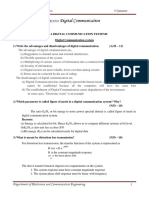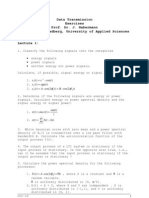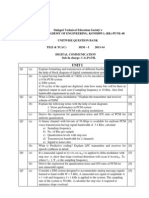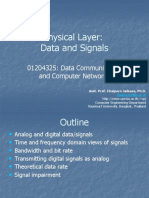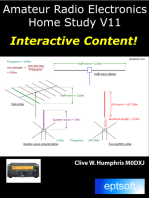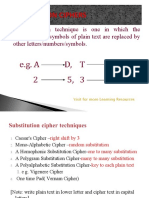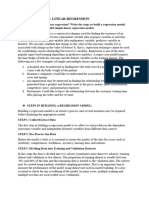0 ratings0% found this document useful (0 votes)
62 viewsTutorial 1 Assignment
The document discusses fundamentals of wireless digital communication through 15 tutorial questions divided among 5 groups. The questions cover topics such as minimum bandwidth requirements, Nyquist sampling rate, correlation, channel capacity, convolution, spectrum analysis, and autocorrelation functions. Modifying systems to cope with SNR variations and representing arbitrary functions as sums of even and odd components are also addressed.
Uploaded by
baaaaNDSCopyright
© © All Rights Reserved
Available Formats
Download as PDF, TXT or read online on Scribd
0 ratings0% found this document useful (0 votes)
62 viewsTutorial 1 Assignment
The document discusses fundamentals of wireless digital communication through 15 tutorial questions divided among 5 groups. The questions cover topics such as minimum bandwidth requirements, Nyquist sampling rate, correlation, channel capacity, convolution, spectrum analysis, and autocorrelation functions. Modifying systems to cope with SNR variations and representing arbitrary functions as sums of even and odd components are also addressed.
Uploaded by
baaaaNDSCopyright
© © All Rights Reserved
Available Formats
Download as PDF, TXT or read online on Scribd
You are on page 1/ 2
Tutorial 1: Fundamentals of Wireless Digital communication
Group 1:
1. A system with digital signaling is operated at 4800 bits per second. If the
signal element encodes a 4-bit word, what is the minimum required
bandwidth?
2. A signal g(t) is given by the expression g(t)=sin At/πt. Determine the nyquist
frequency for sampling this signal.
3. If the correlation is to find out between two signals x[n]=[-1,0,1] and y[n]=[-
1,0,1], what is the expected result? If the order of correlation is changed, will
we get any difference in the result?
Group 2:
4. In a multilevel signaling, if the number of discrete signal or voltage levels is
8 in a MODEM and bandwidth is of 4kHz, find out the channel capacity. If
the data rate is increased by increasing the number of signaling elements, for
a given bandwidth, what will be the expected changes? Comment on it.
5. What is the least sampling sampling rate required to sample the signal
f(t)=sin3(ωt)? Show graphically the effect caused by reduction of sampling
rate, falling below the nyquist rate.
6. If x(n) and h(n) are equal to [-1,0,1]. Find out the convolution between x(n)
and h(n) and also between h(n) and x(n). Is the order of convolution
important? Why?
Group 3:
7. A channel bandwidth is 2MHz and SNR=25dB. Using Shannon’s formula,
find out the channel capacity. If we assume that we can achieve this limit
based on the nyquist formula, find out the number of signaling levels
required.
8. The spectral range of a modulated signal extends from 1MHz to 1.2MHz.
Find out the minimum sampling rate and maximum sampling time.
9. Evaluate the convolution integral sin t u(t)*u(t).
Group 4:
10.If the bit rate is to be maintained to 10Mbps, what modifications should be
made in the system to cope up with the SNR variations between 10dB to
20dB.
11.Determine the energy spectral density of the square pulse s(t)=rect(t/T),
where rect(t/T)=1; for and equals zero elsewhere. Calculate the
normalized energy Es in the pulse.
12. If g(t)*f(t)=c(t), then show that g(t-T1)*f(t-T2)=c(t-T1-T2).
Group 5:
13.If square pulses, each of duration 0.05µsec, are to be transmitted at a carrier
frequency of 100MHz, what will be the shape of the spectrum? According to
this spectrum, find out the
a. Null to null (significant bandwidth)
b. Fractional power containment bandwidth
c. Bounded power spectral density
d. Absolute bandwidth
Hint:
Fractional power containment bandwidth: According to FCC rules,
the occupied bandwidth is the band that levels exactly 0.5% of the signal
power above the upper band limit and exactly 0.5% of the signal power
below the lower band limit. Thus, 99% of the signal power is inside the
occupied bandwidth.
Bounded power spectral density: Typical attenuation level might be 35
or 50dB.
Absolute bandwidth: It is the interval between frequencies beyond
which the spectrum is zero. However, for all realizable waveforms,
absolute bandwidth is infinite.
14.Show that an arbitrary function s(n) can be represented by a sum of even
function se(n) and odd function s0(n). i.e. s(n)= se(n)+ s0(n).
15.Find the autocorrelation function s(t)=A cos(2πfct+ϴ) in terms of its period
Tc=1/fc. Using this result, find out the autocorrelation function of waveform
s(t)=5cos5t+10cos10t.
You might also like
- Electronics and Communication Engineering by M. Handa (Selected Chapters)100% (1)Electronics and Communication Engineering by M. Handa (Selected Chapters)41 pages
- Fundamentals of Digital Modulation - AhmedNo ratings yetFundamentals of Digital Modulation - Ahmed61 pages
- Wireless Communication Systems Module 4: Digital Modulation and Pulse Shaping TechniquesNo ratings yetWireless Communication Systems Module 4: Digital Modulation and Pulse Shaping Techniques9 pages
- QB EEE-5th Communication Theory RAVEEN YADAVNo ratings yetQB EEE-5th Communication Theory RAVEEN YADAV6 pages
- College of Engineering & Technology: Heet ATA RansmissionNo ratings yetCollege of Engineering & Technology: Heet ATA Ransmission2 pages
- Columbia University Mention of Hedy LamarrNo ratings yetColumbia University Mention of Hedy Lamarr44 pages
- Data and Signals: M. Mozammel Hoque Chowdhury, Dept. of CSE, JUNo ratings yetData and Signals: M. Mozammel Hoque Chowdhury, Dept. of CSE, JU38 pages
- SL N o Un It Quest Ion No Answer Rem ArkNo ratings yetSL N o Un It Quest Ion No Answer Rem Ark21 pages
- Chapter 3 - Data Transmission: Concepts and TerminologyNo ratings yetChapter 3 - Data Transmission: Concepts and Terminology45 pages
- Rinciples of Communication Systems EEE: C) LightNo ratings yetRinciples of Communication Systems EEE: C) Light10 pages
- ECE 361: Problem Set 4: Problems and Solutions Capacity and SamplingNo ratings yetECE 361: Problem Set 4: Problems and Solutions Capacity and Sampling5 pages
- Exam in Digital Communications, EITG05: October 26, 2017No ratings yetExam in Digital Communications, EITG05: October 26, 20177 pages
- Chapter 3 - Data Transmission: Concepts and TerminologyNo ratings yetChapter 3 - Data Transmission: Concepts and Terminology45 pages
- Web For Digital Communication - B.tech 5th Sem0% (1)Web For Digital Communication - B.tech 5th Sem15 pages
- CSE 315 Lecture-No.3 (Spring 2022) - Transmission Media and Channel CapacityNo ratings yetCSE 315 Lecture-No.3 (Spring 2022) - Transmission Media and Channel Capacity63 pages
- Basics of Data Transmission: Our Objective Is To UnderstandNo ratings yetBasics of Data Transmission: Our Objective Is To Understand29 pages
- Singal and Communication I Question For Cat PreparationNo ratings yetSingal and Communication I Question For Cat Preparation5 pages
- Fundamentals of Electronics 3: Discrete-time Signals and Systems, and Quantized Level SystemsFrom EverandFundamentals of Electronics 3: Discrete-time Signals and Systems, and Quantized Level SystemsNo ratings yet
- Quantitative Analysis For Management III: Course Instructor: SoniaNo ratings yetQuantitative Analysis For Management III: Course Instructor: Sonia24 pages
- Constraints in Mine Planning and Design in Raniganj CoalfieldNo ratings yetConstraints in Mine Planning and Design in Raniganj Coalfield3 pages
- Lecture - 11 - Stabiity Analysis TechniquesNo ratings yetLecture - 11 - Stabiity Analysis Techniques51 pages
- REMOTE Data Scientist: Militsa KodjabashevaNo ratings yetREMOTE Data Scientist: Militsa Kodjabasheva1 page
- Data Mining Task Primitives and Major IssuesNo ratings yetData Mining Task Primitives and Major Issues18 pages
- Efficient Digital Encryption Algorithm Based On Matrix Scrambling TechniqueNo ratings yetEfficient Digital Encryption Algorithm Based On Matrix Scrambling Technique12 pages
- Linktransformer:: A Unified Package For Record Linkage With Transformer Language ModelsNo ratings yetLinktransformer:: A Unified Package For Record Linkage With Transformer Language Models16 pages
- Download full (Ebook) Multi-factor Models and Signal Processing Techniques: Application to Quantitative Finance by Serges Darolles, Patrick Duvaut, Emmanuelle Jay ISBN 9781848214194, 1848214197 ebook all chapters100% (2)Download full (Ebook) Multi-factor Models and Signal Processing Techniques: Application to Quantitative Finance by Serges Darolles, Patrick Duvaut, Emmanuelle Jay ISBN 9781848214194, 1848214197 ebook all chapters67 pages
- Desain Sistem Kontrol Level Cairan Dengan Metode PID Berbasis PLC - Manuscript+6-2-8+ (195-209)No ratings yetDesain Sistem Kontrol Level Cairan Dengan Metode PID Berbasis PLC - Manuscript+6-2-8+ (195-209)15 pages




























